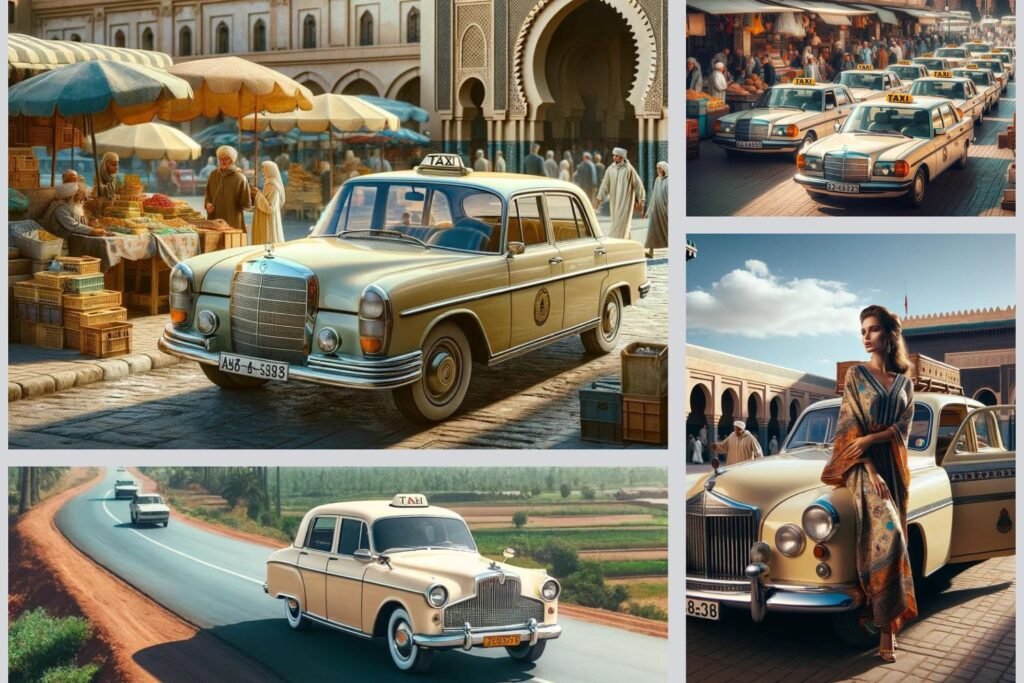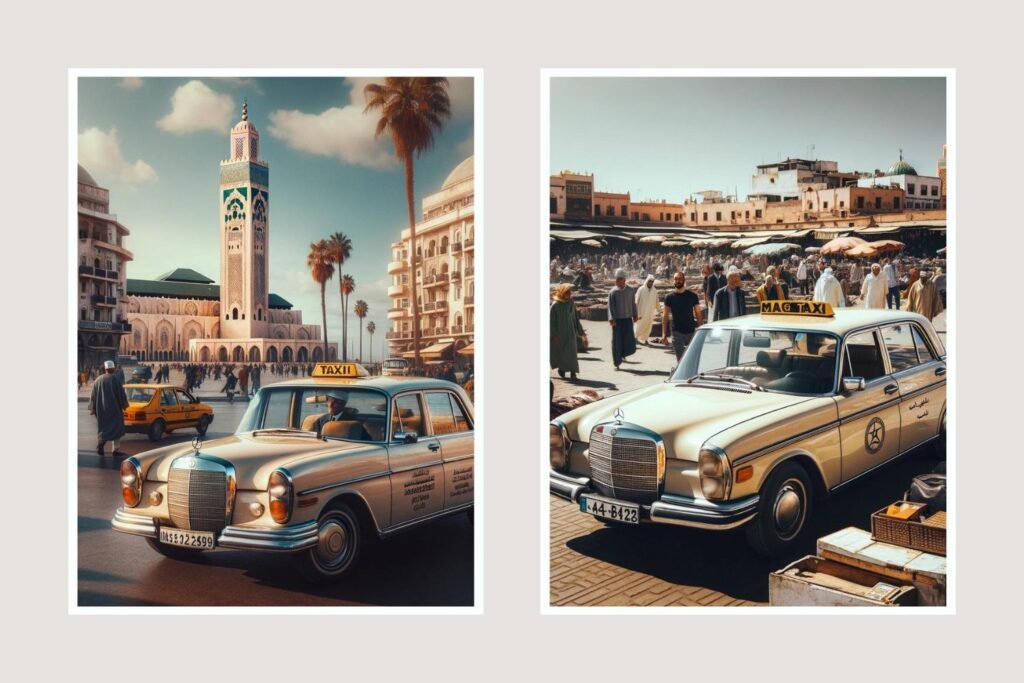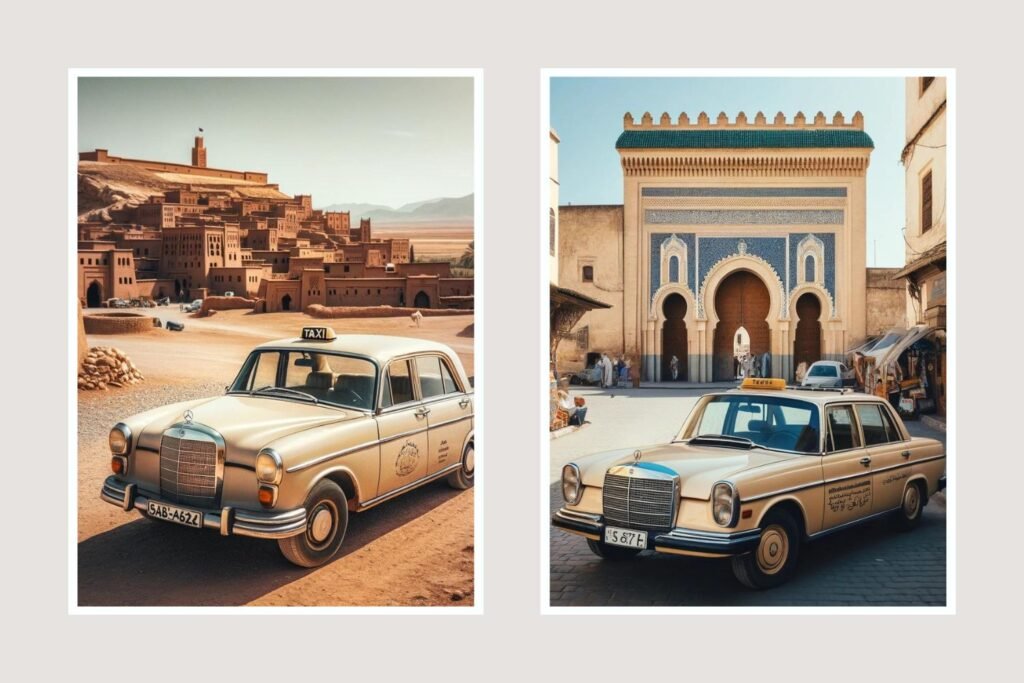MOROCCO grand taxi. In Morocco, the “grand taxi” is a popular mode of transportation, especially useful for traveling longer distances between cities or rural areas where other forms of public transit might not be as prevalent. These taxis are typically larger vehicles, such as older Mercedes-Benz sedans, and can accommodate more passengers than the smaller city taxis. Grand taxis operate on fixed routes and have set fares for specific destinations, but they don’t leave until the vehicle is full unless passengers agree to pay for the remaining seats. This makes them an economical option for both locals and tourists who are looking to explore different parts of the country.

Grand taxis in Morocco are a quintessential part of the country’s transportation infrastructure, bridging the gap between urban and rural regions. Here are more details about their operation and cultural significance:
1. Types of Vehicles: Grand taxis are usually older, large sedans that can comfortably seat six passengers, aside from the driver. Common models include the Mercedes-Benz 240D and Peugeot 504. These vehicles are chosen for their durability and spaciousness.
2. Color Coding: They are often painted in a cream color, which distinguishes them from the smaller, usually blue, city taxis (petit taxis). This color-coding helps passengers easily identify the type of taxi service.
3. Fixed Routes and Shared Rides: collective taxis generally operate on predetermined routes. They connect major cities to each other and also provide vital links to rural villages that might not be accessible by bus or train. Passengers share these taxis with others, which makes them a cost-effective form of transport. The taxi only departs once all seats are filled, or passengers can choose to pay for the extra seats to depart sooner.
4. Fares and Negotiation: Fares are usually fixed for standard routes, but there is often room for negotiation, especially if the route is less common or if passengers are hiring the whole taxi for themselves. It’s advisable for travelers to inquire about the fare before beginning their journey to avoid misunderstandings.
5. Cultural Experience: Riding in a shared taxi offers a unique cultural insight into Moroccan life. It’s not uncommon for passengers to chat and share stories, making the ride a communal and social affair. For many tourists, this becomes a memorable part of their travel experience.
6. Regulation and Availability: Grand taxis are regulated by local authorities, which helps in maintaining standard fares and ensuring that the taxis are in reasonable condition. They are widely available at bus stations, airports, and major points of interest.
Grand taxis not only serve as a practical transportation solution but also play an integral part in the social and economic connectivity within Morocco
Characteristics of grand taxis in Morocco

Expanding further on the role and characteristics of grand taxis in Morocco, let’s delve into their operational nuances, social importance, and challenges:
Operational Nuances
– Terminal Points: Grand taxis typically operate from designated taxi stands or terminals, which are commonly found near city centers, main squares, or near train stations. These locations serve as both starting points and destinations for various routes.
– Inter-City Travel: For inter-city travel, shared taxis are a preferred choice over buses by many due to their speed and direct routes. They often take less time than buses as they do not make multiple stops along the way, except to pick up or drop off passengers along the fixed route.
Social Importance
– Economic Lifeline: For many rural communities, grand taxis are an economic lifeline, providing the only viable means of reaching larger towns where people can access better healthcare, education, and marketplaces to sell their goods.
– Cultural Interactions: The shared nature of grand taxis fosters interactions among Moroccans from different walks of life. It is not just a journey; it’s often a place for lively discussions and exchange of news, helping to knit the social fabric of the country.
Challenges
– Comfort and Safety: The vehicles used as shared taxis are often quite old and can sometimes be poorly maintained. This raises concerns about comfort during long journeys and, more importantly, passenger safety.
– Overcrowding: To maximize earnings, drivers sometimes exceed the standard passenger limit, leading to cramped conditions. This practice, while common, detracts from the comfort and can impact the overall travel experience.
– Environmental Impact: Being older models, the cars typically used as grand taxis are not fuel-efficient and are significant contributors to air pollution, particularly in urban centers.
Future Trends
– Modernization Efforts: There are ongoing discussions and initiatives aimed at modernizing the fleet of shared taxis to improve safety standards and reduce environmental impacts. This includes replacing older vehicles with newer models that are more energy-efficient and have better safety features.
– Regulatory Changes: Authorities are increasingly looking into stricter regulations to improve the operation of shared taxis. This includes enforcing the vehicle’s capacity limits, regular maintenance checks, and possibly integrating technology for route and fare management to standardize operations and improve transparency.
Grand taxis remain a staple of Moroccan transport, emblematic of the country’s robust informal economy and vibrant public life. As Morocco continues to grow and modernize, the grand taxi system faces both challenges and opportunities for improvement, reflecting broader changes in Moroccan society
For any inquiries or assistance, please don’t hesitate to contact us.

